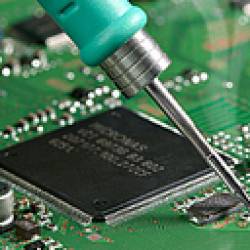
Op-Amp Audio Amplifier
Op-amp stands for operational amplifier IC. This amplifier can be made in real life. It is a typical op-amp AC amplifier circuit. You need to connect this circuit to a power amplifier. This circuit cannot drive the speaker.
Supplies
All components are shown in the circuit. The Rs3 potentiometer can be made from two 47 kohm resistors. This will be the same as setting Rs3 potentiometer to midpoint. However, then you will not be able to connect this circuit to the LED bar graph display (oscilloscope output). The 1 Megohm can be a dual-gang variable resistor to avoid using two variables resistors. You can use LM747 instead of LM324 because LM324 has four operational amplifiers and this circuit is only showing two op-amp amplifiers. However, LM747 has offset trimming options that you do not need and LM324 can be useful if you burn two op-amps by shorting the outputs you still have two more left and thus do not have to order again online.
Other components: wire wrap socket, wire-wrap wire, matrix board.
Tools: Wire wrap.
Optional: USB oscilloscope, multi-meter, soldering iron (do not really need in my opinion).
The current entering the operational amplifier is zero and the voltage across both input terminals is also near zero.
Not all microphones can work with such high biasing resistors (22 kohms). Thus you might need to bias the microphone with a voltage reference circuit shown here:
https://www.instructables.com/id/Op-Amp-Voltage-Re...
Then you replace Rm1 with Ro (1 kohm) in the voltage reference circuit and connect the output of the microphone to C1b. You can also create a separate voltage reference for the operational amplifier positive terminal input and connect the output of voltage reference to Rs1 resistor. However, then you will need four operational amplifiers, not just two. The software that I used is a student version and does not allow too many nodes. Thus I could not draw a third op-amp amplifier for the microphone voltage reference.
The first operational amplifier is an op-amp mixer. Rm2 is needed to protect the microphone when Vi1 is set to the maximum value.
Ro is used for short circuit protection. An operational amplifier cannot supply a current more than 10 mA. Thus 9 V / 1000 ohms = 9 mA maximum op-amp output current during a short circuit.
Upper cut-off frequency calculations for the power supply noise:
fu1 = 1/(2*pi*1000 ohms*(470 uF)) = 0.3386 Hz
fu2 = 1/(2*pi*22000 ohms*(47 uF)) = 0.1539 Hz
Lower cut-off frequency calculations for bandwidth:
Op-Amp 1: fl1 = 1/(2*pi*R1lineIn*C1) = 1/(2*pi*22000*(470*10^-9)) = 15.3922 Hz
Op-Amp 2: fl2 = 1/(2*pi*R2*C2) = 1/(2*pi*22000*(470*10^-9)) = 15.3922 Hz
Op-Amp 2 output: fol2 = 1/(2*pi*Ro*Co) = 1/(2*pi*1000*(10*10^-6)) = 15.9155 Hz
In my personal opinion, the lower cut-off must be below 20 Hz for an audio amplifier. Many HiFi audio amplifiers have 20 Hz cut-off frequencies.
The op-amp upper cut-off frequency = Gain Bandwidth Product / Gain
The higher is the gain, the lower is the bandwidth of this amplifier.
There are two op-amp amplifiers in the circuit.
Gain1 = ((Rf1a + Rf1b) / R1lineIn + 1)
Gain2 = ((Rf2a + Rf2b) / R2 + 1)
The maximum gain for each op-amp is about 40. Thus you can do the calculations for upper cut-off frequency yourself by searching for the op-amp IC specifications online.
You can increase the gain by reducing the R1lineInor R2 value to 1 kohm. However, this will increase the lower cut-off frequency of each op-amp amplifier. The cut-off frequency can be reduced by increasing the C1 and C2 values. I have chosen 470 nF (the maximum value for pillow capacitors) to avoid using electrolytic capacitors. Do not increase the value of feedback resistors (Rf1b or Rf2b). This will increase the gain but also the effect of op-amp offset and bias currents that will saturate the amplifier.
Total Gain = Gain1*Gain2 = ((Rf1a + Rf1b) / R1 + 1) * ((Rf2a + Rf2b) / R2 + 1)
You can make another U2A circuit and connect to output of U2A. If you are using an LM324 IC you can cascade two more op-amp amplifiers.
The microphone needs biasing. Keep in mind that some microphones might have a maximum biasing voltage that should not be exceeded. Increasing the Rm1 value will increase the chances that this maximum biasing voltage is not exceeded. However, then the amplifier gain for microphone input will be smaller. The 22 kohm value that I have chosen is sufficient. The microphone might need a smaller resistor so that it is biased at higher current value. However, reducing the Rm1 value will affect the op-amp biasing. Rm1 must be greater than 10 kohms.
If microphone is short circuit than we can calculate the maximum Vi1 value:
Maximum Vcs1 = (Vs * Rm1 * (Rs2 + Rs3) / (Rm1 + Rs2 + Rs3)) / (Rm1 * (Rs2 + Rs3) / (Rm1 + Rs2 + Rs3) + Rs1)
= (9 * 22000 * 122000 / (22000 + 122000)) / (22000 * 122000 / (22000 + 122000) + 1000) = 8.5417
Maximum Vi1 = (Maximum Vcs1) * Rs3 / (Rs2 + Rs3) = 8.5417 * 100000 / (22000 + 100000) = 7.0014 V
The op-amp saturation voltage is at least 2 V. Thus the maximum op-amp output value will not exceed (9 V - 2 V) = 7 V. Thus op-amp input does not have to be above 7 V for AC opamp amplifier.
I used PSpice software for simulations.
It is unlikely that the circuit will work at frequencies above 20 kHz. Most op-amps have low bandwidth.
You are now done.


